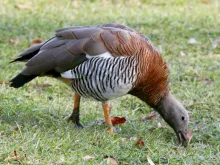
Ashy-headed Goose (Chloephaga poliocephala)
Species name
- Dutch name:
- Grijskopgans
- English name:
- Ashy-headed Goose
- German name:
- Graukopfgans
- French name:
- Ouette à tête grise
- Scientific name:
- Chloephaga poliocephala
Scientific classification
- Order:
- Anseriformes
- Family:
- Anatidae
- Onderfamilie:
- Anserinae
- Genus:
- Chloephaga
Description
- Description:
Male:
The male has a grey head (whitish eye-ring), a chestnut breast, and white sides and abdomen overlaid with vertical black barring. The rump and tail are black and the under tail coverts pale chestnut, while the mantle is brown. The bill is black, and the legs and feet are two-toned orange and black. The wings are white, secondaries are iridescent green secondary coverts, the other coverts being white.Female:
Females are as Males in appearance but, are smaller and have somewhat barred breasts,Juvenile:
Young Ashy-headed goslings are more extensively brownish and have brown rather than iridescent coverts.
Standard Measurements
- Body Length (cm):
- The male (drake) of the Ashy-headed Goose measures approximately 51-60 centimeters. The female measures approximately 48-57 centimeters.
- Body Weight (grams):
- The male will weight about 2200-2280 gram. The female will weight about 2120-2245 gram.
The weight is notoriously variable and can only be used as indication!
- Habitat:
Sheldgeese are generally hardy, and mostly aggressive particularly in the breeding season, so that pairs require a separate pen. A pen for a pair of these birds may be 80% grazing land to 20% water, with a minimum size of 200 square metres for the smaller species (e.g. Orinoco goose) and 300 square metres for the larger species.
- Note:
Ashy-headed geese are winter-hardy and easy to keep, but aggressive to other waterfowl, with ganders particularly aggressive in the breeding season; a separate enclosure is recommended. Good grass for grazing should be provided as well as a pond of clean water, preferably running, and a shelter if possible.
This species is fairly easy to breed. Good ground cover should be available for nesting, also a kennel-type box or wigwam. Eggs are usually laid end of March to May. These sheldgeese are usually reliable incubators. Goslings are robust and may be parent-reared on good grazing.
Hybridisation is not common (usually kept in separate enclosures), but has been reported with Barnacle goose (Branta leucopsis), Paradise shelduck (Tadorna variegata), Australian shelduck (Tadorna tadornoides).
Ashy-headed geese are reasonably common in collections.
- Breeding:
- The female Ashy-headed Goose usually lays from 4-6 pale brown eggs and incubates them for 30 days.
- Artificial incubating:
The ideal relative humidity for incubating most waterfowl eggs is 55% (ground nesters) and 40% (cavity nesters). The temperature is usually 37.4°C. Set ventilation as recommended by the incubator manufacturer. Eggs must be turned, either automatically or by hand, a minimum of 4 times a day. As the duckling develops there is a loss of water from the egg and the air sac gets bigger. In normal development of an egg with a 30 days incubation, the air sac occupies about a third of it three days earlier. Cleanliness is vital and ideally eggs should be moved to a separate hatcher at this point, where the humidity should be increased to 65% and even higher once they have pipped internally.
- Bird banding:
- Recommended closed leg band ring size for the Ashy-headed Goose is 14 mm.The leg band ring can only be applied on a young sheldgoose at around 12-14 days old.
- It doesn't matter what leg that you band, but it's good to have a consistent system. Suggested: Left leg = Female, Right leg = Male
- Maintenance food:
-





Lundi Regular with a protein content of 20%, valuable Spirulina and high-quality by-products is optimally balanced in its composition maintenance food for water ornamental fowl of all kinds. Especially green teal and Whistling ducks that are not dependent on a very high protein content, are well supplied.
Lundi Regular contains all the minerals and vitamins in full form that are important for the animals. Therefore also suitable as breeding food.

